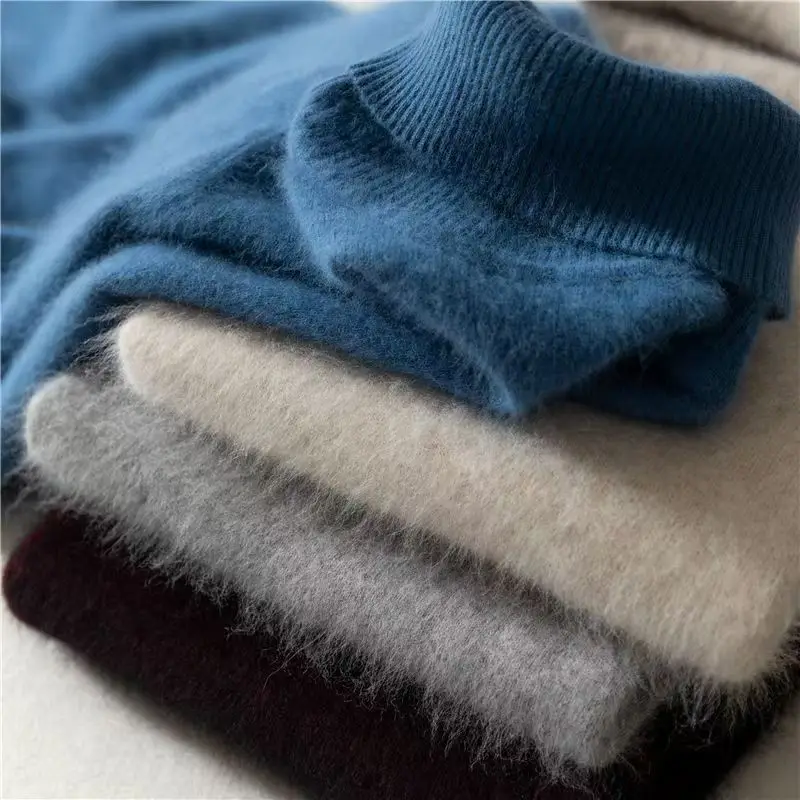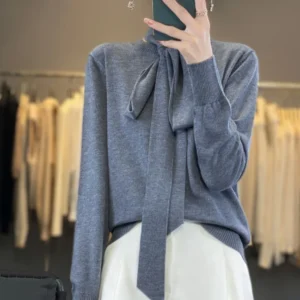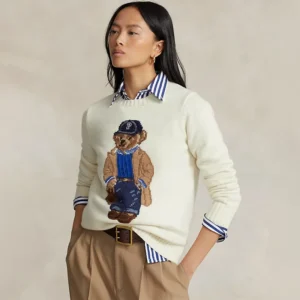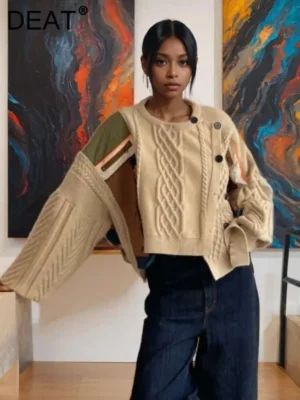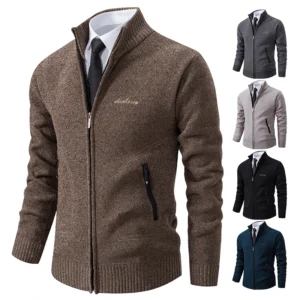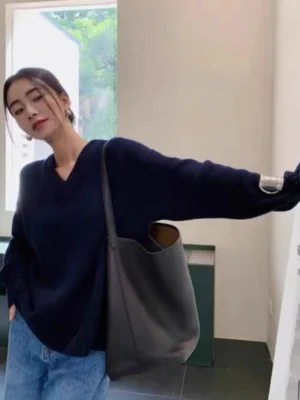Introduction
The soft embrace of cashmere against your skin doesn’t have to be reserved for weekends or casual settings. This luxurious natural fiber offers the perfect blend of comfort and sophistication that makes it ideal for professional environments. Cashmere, derived from the soft undercoat of cashmere goats, brings a touch of subtle luxury to workplace attire while providing practical benefits that enhance your day-to-day comfort.
When styled thoughtfully, cashmere pieces strike that elusive balance between comfort and professionalism that many office workers seek. The versatility of this premium material allows it to adapt seamlessly to various workplace dress codes while elevating your professional presence.
In this comprehensive guide, we’ll explore:
– Foundational principles for selecting office-appropriate cashmere
– Styling techniques for different cashmere garment types
– Layering strategies that maximize versatility
– Care methods that maintain a polished professional appearance
Cashmere stands as an investment in both comfort and career image. When selected with care and styled with intention, these pieces become workhorses in a professional wardrobe, offering exceptional styling tips for cashmere cardigans and other versatile pieces that transition effortlessly between seasons and settings.
Why Cashmere Stands Out for Professional Attire
Not all luxury fabrics translate well to professional environments, but cashmere possesses unique properties that make it exceptionally well-suited for office wear. Understanding these qualities helps explain why this premium material deserves space in your work wardrobe.
Cashmere offers unparalleled benefits for the professional setting:
Temperature regulation: Cashmere fibers contain natural temperature-regulating properties that keep you comfortable whether your office runs cold or warm. The breathable nature of the fiber prevents overheating while its insulating capacity provides warmth when needed.
Lightweight comfort: Unlike bulky wools, cashmere provides exceptional warmth without weight or bulk, allowing for elegant layering without a stuffed or restricted feeling during long meetings or workdays.
Natural drape and structure: The way cashmere naturally falls against the body creates clean lines and a polished silhouette—essential for maintaining professional appearance throughout demanding workdays.
Subtle luxury: Cashmere communicates refinement without ostentation, making it appropriate even in conservative work environments where flashy materials might seem inappropriate.
Versatility across seasons: High-quality cashmere works year-round, from lightweight summer knits to substantial winter layers, making each piece a true wardrobe investment.
When compared to other professional fabrics, cashmere outperforms in both comfort and appearance. While merino wool provides warmth, it generally lacks cashmere’s exceptional softness. Cotton, though breathable, doesn’t offer the same insulation or natural elegance. And synthetic blends, while often more affordable, simply cannot match the temperature regulation or tactile pleasure of pure cashmere sweaters.
Foundational Principles for Office-Appropriate Cashmere
Before exploring specific garment types, it’s important to establish fundamental principles that guide the selection of cashmere pieces suitable for professional environments. These guidelines will help ensure your cashmere selections enhance rather than detract from your workplace presence.
Fit Considerations:
– Opt for tailored, streamlined silhouettes in formal environments
– Ensure adequate length in sweaters (no midriff exposure when reaching)
– Avoid excessively oversized styles in traditional office settings
– Choose slim-fitting pieces that layer smoothly under jackets or blazers
Color Strategy:
– Build a foundation of neutral tones (navy, gray, black, camel, cream)
– Incorporate subtle color based on your industry’s conventions
– Consider deeper, richer hues for conservative environments
– Save brighter colors for accent pieces or more creative workplaces
Quality Indicators:
– Look for tight, even stitching at seams
– Seek dense knits that won’t become transparent
– Choose appropriate weights (heavier gauge for standalone pieces, finer for layering)
– Ensure minimal pilling potential for maintained professionalism
Neckline Selection:
– V-necks pair elegantly with collared shirts
– Crew necks offer versatility across dress codes
– Turtlenecks provide sophistication with streamlined elegance
– Avoid deeply plunging necklines in professional settings
These principles create a framework for styling cashmere professionally for office environments across different industries and dress code requirements. By adhering to these guidelines, you ensure that comfort never comes at the expense of professionalism, and luxury enhances rather than undermines your workplace credibility.
Styling Classic Cashmere Sweaters for Different Office Environments
The classic cashmere sweater forms the foundation of a professional cashmere wardrobe. Its versatility allows it to adapt to various workplace dress codes with thoughtful styling. Here’s how to maximize this essential piece across different professional environments:
For Traditional/Business Formal Settings:
– Layer fine-gauge V-neck sweaters over crisp button-down shirts with the collar neatly arranged
– Pair with tailored wool trousers or pencil skirts in coordinating neutral tones
– Complete with polished leather shoes and minimal, refined accessories
– Opt for darker neutrals like charcoal, navy, or black for maximum formality
– Ensure a slim fit that presents a clean silhouette under blazers or suit jackets
For Business Casual Environments:
– Wear crew necks with collared shirts or on their own with tailored bottoms
– Incorporate subtle pattern or texture through trousers or accessories
– Consider medium-weight knits that provide structure without additional layers
– Expand color options to include burgundy, forest green, or subtle heather tones
– Pair with chinos, wool blend trousers, or appropriate-length skirts
For Smart Casual/Creative Offices:
– Experiment with modern silhouettes like slightly oversized styles with slim bottoms
– Mix in contemporary details like side slits or subtle texture variations
– Layer under unstructured blazers or modern outerwear
– Incorporate denim (if permitted) with darker washes and no distressing
– Consider color-blocking or monochromatic layering for artistic environments
For those who prefer V-neck styles, men’s V-neck cashmere sweaters offer particularly versatile options. A navy V-neck paired with light blue Oxford shirt, charcoal trousers and brown leather shoes creates a universally appropriate office ensemble that works across multiple settings.
When transitioning the same piece between different environments, accessories and complementary garments become crucial differentiators. A cashmere sweater that works under a suit jacket for client meetings can later be paired with dark jeans for casual Friday by simply changing bottom pieces and accessories.
Elevating Your Office Look with Cashmere Turtlenecks
The cashmere turtleneck offers a distinctly sophisticated silhouette that brings instant polish to professional ensembles. This versatile piece strikes a perfect balance between comfort and elegance while providing practical warmth during cooler months.
For Business Formal Settings:
– Select fine-gauge, fitted turtlenecks in solid neutral colors
– Layer under tailored blazers or suit jackets, allowing just the neck portion to show
– Pair with matching suit components for a modern monochromatic look
– Ensure adequate length for clean tucking into high-waisted trousers or skirts
– Keep accessories minimal and refined to maintain formality
For Business Casual Environments:
– Wear as a standalone top with tailored trousers or skirts
– Layer under cardigans or unstructured blazers for added dimension
– Consider subtle ribbing or texture details for visual interest
– Incorporate complementary accessories like simple pendants or watches
– Experiment with rich, deeper colors beyond basic neutrals
For Smart Casual Offices:
– Try relaxed turtlenecks with more contemporary proportions
– Pair with wide-leg trousers or A-line skirts for modern silhouettes
– Layer under vests or sleeveless dresses for creative combinations
– Incorporate thoughtful color contrasts or tonal layering
– Add statement accessories that reflect personal style while maintaining professionalism
To avoid common turtleneck pitfalls in professional settings, select pieces with appropriate thickness—too bulky appears casual, while too thin may lack structure. For jewelry, skip necklaces but consider earrings or bracelets that complement without competing with the neckline.
The cashmere turtleneck’s natural elegance makes it particularly effective for presentations, important meetings, or situations requiring confidence and authority. The clean lines frame the face beautifully while eliminating concerns about gaping buttons or shifting collars during busy workdays.
Mastering Cashmere Cardigans in the Workplace
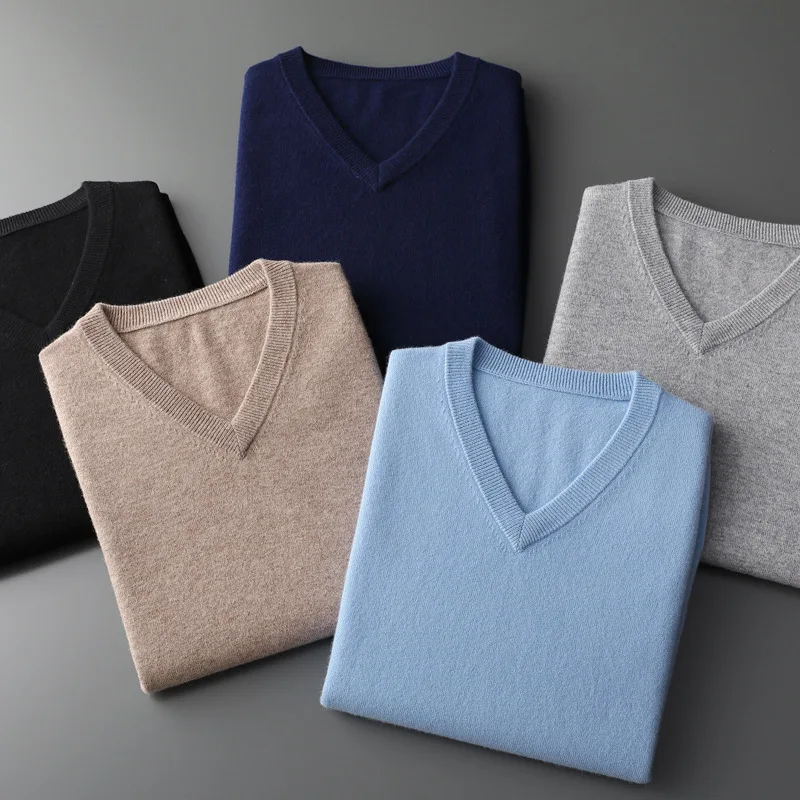
Cashmere cardigans offer exceptional versatility for professional environments, functioning as both elegant layering pieces and sophisticated standalone tops. Their adaptability makes them invaluable for navigating unpredictable office temperatures while maintaining polished appearance.
Fine-Gauge Button-Front Cardigans:
– Substitute for blazers in business casual settings
– Button completely for a sweater-like appearance with skirts or trousers
– Select styles with reinforced buttonholes that maintain shape
– Look for subtle details like ribbed cuffs and hems for structure
– Choose neutral tones for maximum versatility across outfits
Longline Cardigans:
– Create vertical lines that elongate the silhouette
– Layer over matching shells for sophisticated column dressing
– Belt at the waist to create definition in looser styles
– Pair with slim-fitting bottoms to balance proportions
– Select mid-weight knits that drape without clinging
V-Neck vs. Round Neck Considerations:
– V-neck cardigans layer beautifully over collared shirts and blouses
– Round necks offer a more casual appearance suitable for creative environments
– V-necks create a lengthening effect beneficial for professional presentation
– Round necks work well with statement necklaces or scarves
– Consider face shape and neckline preferences when selecting between styles
For temperature management, cashmere cardigans excel by providing breathable warmth without bulk. Keep a neutral cardigan at your desk for unexpected air conditioning or transitions between heated and cooled environments. The styling tips for cashmere cardigans can transform a single piece into numerous professional looks through thoughtful layering and accessorizing.
When selecting office cardigans, pay particular attention to details like pocket placement (which can add bulk) and button quality (which signals overall garment quality). These seemingly minor elements significantly impact the professional appearance of the finished look.
Luxurious Statements: Cashmere Blazers and Jackets
For those seeking to make a more substantial cashmere investment, cashmere blazers and structured jackets represent the pinnacle of professional luxury. These pieces combine the formality of tailored outerwear with the unparalleled comfort of premium cashmere.
Cashmere blazers offer several advantages over traditional wool options:
– Softer drape that creates an elegant silhouette
– Natural stretch that accommodates movement without wrinkling
– Lighter weight that prevents overheating in heated offices
– Subtle luster that elevates the overall appearance
– Superior comfort during long days or extended wear
When styling cashmere outerwear for professional settings, structural elements become crucial. Look for:
– Defined shoulders (with light padding or structured seaming)
– Proper lapel proportion appropriate for your frame
– Functioning buttons and pockets that maintain formality
– Clean lining that facilitates smooth movement over other layers
– Appropriate length that creates balanced proportions
Cashmere blazers work beautifully in both traditional and contemporary professional environments. In more formal settings, select classic cuts in navy, black, or camel. For creative workplaces, consider subtly textured cashmere or relaxed silhouettes that maintain structure while adding visual interest.
The ultimate guide to layering cashmere cardigans provides principles that apply equally well to structured cashmere outerwear. The key difference lies in treating these pieces as statement anchors rather than middle layers—they become the focal point around which other garments are coordinated.
Accessorizing with Cashmere: Scarves, Wraps and Accents
Even when dress codes or personal preference limit cashmere in main garments, accessories offer an accessible entry point for incorporating this luxury fiber into professional wardrobes. These smaller pieces add warmth, texture, and refined detail to workplace ensembles.
Professional Scarf Styling:
– The Classic Drape: Simply centered at the neck, hanging evenly on both sides, works well under coats or jackets
– The Loop: Folding the scarf in half and pulling ends through the loop creates a secure, neat appearance
– The Hidden Knot: Tucking the knot and ends inside a jacket or blazer offers warmth without bulk
– The Office Wrap: Draping wider scarves over shoulders provides elegant coverage in chilly environments
Cashmere Wraps and Shawls:
– Keep one in neutral tones at your workspace for temperature fluctuations
– Fold into triangles for structured draping over shoulders
– Select medium-weight options that don’t add excessive bulk
– Consider classic patterns like herringbone or subtle plaids for versatility
– Opt for edges with clean finishing that maintain professional appearance
Commuting Accessories:
– Cashmere gloves in coordinating colors extend polish to cold-weather gear
– Simple cashmere beanies or caps provide warmth without compromising styled hair
– Cashmere-lined leather gloves offer practical luxury for professional commuters
For maximizing versatility, select accessories in colors that complement your existing professional wardrobe. Neutrals offer greatest flexibility, while strategic color choices can refresh basics or enhance seasonal transitions. The versatile outfit ideas for cashmere cardigans provide excellent inspiration for incorporating complementary accessories that elevate professional looks.
Strategic Layering: Creating Professional Cashmere Ensembles
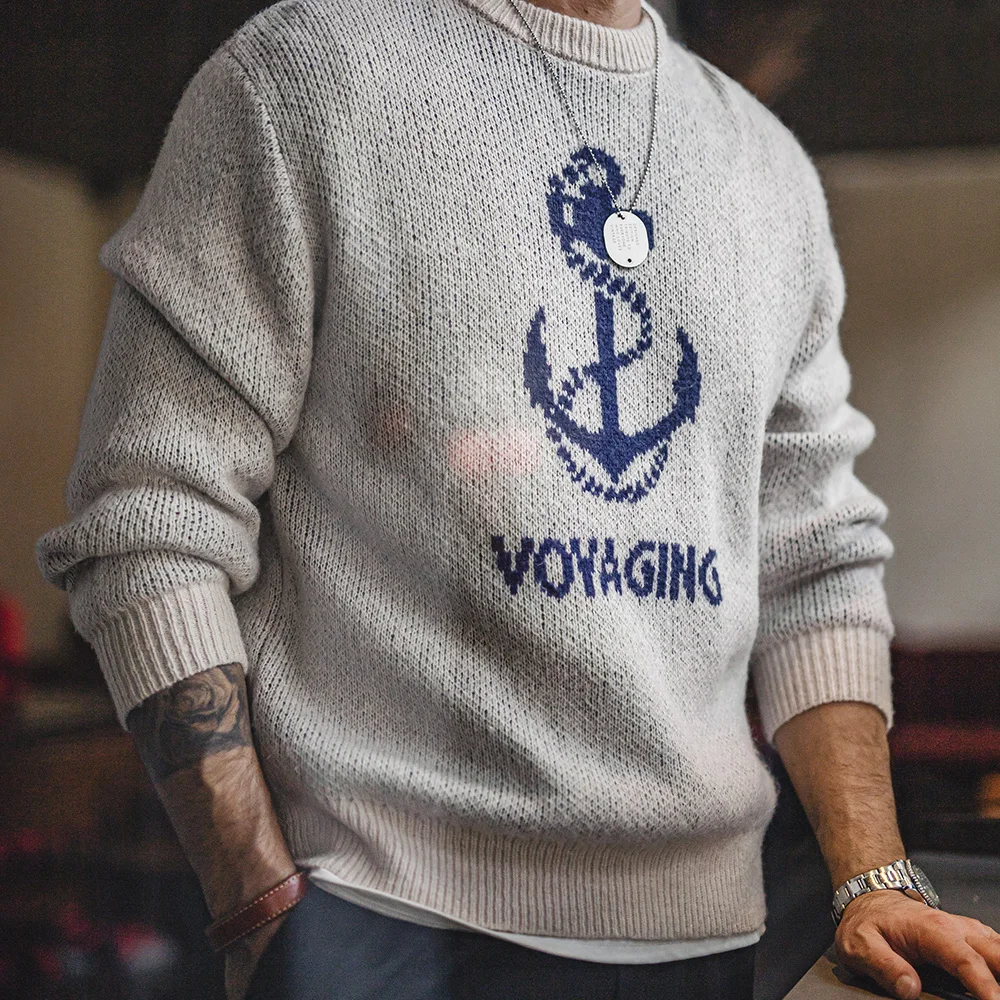
Mastering the art of layering transforms individual cashmere pieces into sophisticated professional ensembles suitable for various workplace settings. Strategic layering not only enhances visual interest but also provides practical temperature management throughout the workday.
Foundation Layers:
– Select smooth, lightweight fabrics that won’t create friction against cashmere
– Choose collared shirts with appropriate collar height for intended sweater necklines
– Opt for fitted silhouettes that don’t add bulk under cashmere layers
– Consider silk, cotton poplin, or fine cotton blends for breathability
– Ensure adequate length in base layers to prevent untucking or shifting
Mid-Layer Cashmere Strategies:
– Fine-gauge V-necks or crews layer seamlessly under blazers or jackets
– Lightweight cardigans function as versatile middle layers in three-piece combinations
– Quarter-zip or partial-button styles provide adjustable neckline coverage
– Sleeveless shells create bulk-free foundations under cardigans or blazers
– Tonal layering (varied shades of one color) creates sophisticated depth
Creating Structured Silhouettes:
– Use belts to define waistlines in longer or drapey pieces
– Layer contrasting colors strategically to highlight or minimize areas
– Balance proportions with slim bottoms under fuller tops or vice versa
– Create intentional color blocking through thoughtful layer combinations
– Incorporate tailored pieces to provide structure alongside softer cashmere elements
For seasonal adaptation, techniques from how to layer cashmere for spring and fall apply perfectly to professional settings. The key difference lies in maintaining workplace-appropriate coverage and refinement throughout layering combinations.
Cashmere Wrap Sweaters, Women's Cashmere Pullovers
$75.89 Select options This product has multiple variants. The options may be chosen on the product pageCashmere Cable Knit Sweaters, Women's Cashmere Pullovers
Price range: $111.82 through $112.93 Select options This product has multiple variants. The options may be chosen on the product pageCropped Cashmere Sweaters, Women's Cashmere Pullovers
$155.77 Select options This product has multiple variants. The options may be chosen on the product page- Price range: $102.02 through $109.37 Select options This product has multiple variants. The options may be chosen on the product page
Oversized Cashmere Sweaters, Plus Size Cashmere Sweaters, Women's V-Neck Cashmere Sweaters
$136.87 Select options This product has multiple variants. The options may be chosen on the product page- Price range: $108.11 through $130.03 Select options This product has multiple variants. The options may be chosen on the product page
Creating a Professional Cashmere Color Strategy
Developing a thoughtful color strategy for professional cashmere pieces maximizes versatility while ensuring workplace appropriateness. The right color selection creates cohesion across your professional wardrobe while expressing appropriate personality and style.
Core Professional Neutrals:
– Navy: Universally flattering and less severe than black
– Charcoal/Medium Gray: Sophisticated and pairs easily with most colors
– Camel/Oatmeal: Warm neutrals that brighten complexions
– Black: Classic and always appropriate in formal settings
– Ivory/Winter White: Elegant options for less conservative environments
Appropriate Accent Colors:
– Burgundy/Merlot: Rich, sophisticated color that functions nearly as a neutral
– Forest/Hunter Green: Subdued yet interesting alternative to basic neutrals
– Sapphire Blue: Vibrant yet professional statement color
– Dusty Rose: Subtle option for incorporating feminine tones
– Heathered or Marled Variations: Add visual texture while maintaining professionalism
Strategic Color Application:
– Invest in neutrals for foundation pieces (turtlenecks, V-necks, cardigans)
– Incorporate accent colors through accessories or secondary layers
– Consider your industry’s color conventions (finance vs. creative fields)
– Reflect seasonal shifts subtly through color depth and temperature
– Create signature combinations that become personal workplace identifiers
Monochromatic styling offers particularly sophisticated options for professional environments. Layering varied textures in similar tones creates visual interest while maintaining refined elegance—for example, ivory cashmere over a cream silk blouse with winter white wool trousers.
When building a professional cashmere collection, start with versatile neutrals in your most frequently worn styles. The cashmere cardigans available in core neutrals provide excellent foundation pieces that work across multiple outfits and settings.
Office-Inappropriate Cashmere: Common Mistakes to Avoid
Even luxury materials like cashmere can undermine professional credibility when selected or styled improperly. Understanding common pitfalls helps ensure your cashmere investments enhance rather than detract from workplace presence.
Style Missteps:
– Oversized, slouchy fits that appear casual rather than intentional
– Extremely tight fits that compromise professional modesty
– Overly distressed or heavily textured knits better suited for weekend wear
– Trendy cuts with extreme proportions that distract in professional settings
– Embellishments like sequins, large logos, or novelty details inappropriate for work
Maintenance Issues:
– Visible pilling that suggests poor quality or improper care
– Stretched-out collars, cuffs or hems that appear sloppy
– Faded color that diminishes the garment’s professional appearance
– Visible staining that hasn’t been properly addressed
– Improper storage evidence like shoulder bumps from hangers
Inappropriate Styling Combinations:
– Cashmere worn with overly casual elements (distressed denim, athletic shoes)
– Layering that creates inappropriate transparency
– Excessive luxury that may appear ostentatious in certain environments
– Mismatched formality levels between cashmere and other garment components
– Proportions that create unflattering or unprofessional silhouettes
Seasonal Inappropriateness:
– Heavy cashmere turtlenecks in summer months
– Ultra-light, potentially transparent knits in conservative settings
– Off-season colors that clash with workplace seasonal norms
– Holiday-specific patterns or colors outside appropriate timeframes
Understanding these potential pitfalls helps professionals make thoughtful cashmere selections that remain workplace-appropriate while maximizing comfort and style.
Maintaining Professional Cashmere: Essential Care for Office Wear

Proper maintenance ensures your professional cashmere remains polished and presentable throughout its lifespan. Office environments present unique care challenges that require specific approaches to preserve your investment pieces.
Quick Daily Maintenance:
– Keep a lint roller at your desk for immediate debris removal
– Gently brush garments with a soft clothes brush before hanging at day’s end
– Allow worn pieces to rest 24 hours before wearing again
– Spot-clean small marks immediately with appropriate techniques
– Use fabric freshening spray designed for delicates between cleanings
Office Hazard Management:
– Keep a stain pen specifically formulated for protein fibers
– Address coffee or food spills immediately with blotting (never rubbing)
– Protect cashmere from rough desk edges that cause friction
– Remove jewelry that might snag fibers before donning or removing pieces
– Shield cashmere from potential ink sources or whiteboard markers
Professional’s Storage Solutions:
– Maintain a quality hanger in your office for proper day storage
– Consider a breathable garment bag for commuting protection
– Fold and store backup pieces in clean desk drawers with cedar or lavender
– Use shoulder guards if hanging for extended periods
– Ensure storage areas remain dry and temperature-controlled
Seasonal Care Routines:
– Schedule professional cleaning at season transitions
– Store properly cleaned pieces in breathable containers during off-seasons
– Address any repairs before storing to prevent worsening
– Document care history for valuable pieces to maintain consistency
– Refresh with gentle steaming rather than ironing when needed
For more detailed guidance on maintaining your professional cashmere in optimal condition, explore our complete guide to cashmere care which provides comprehensive techniques suitable for busy professionals.
Is Cashmere Appropriate for Your Specific Workplace? Evaluating Office Culture
Not all workplaces have the same expectations regarding appropriate attire. Before investing significantly in cashmere for professional settings, consider these questions to determine suitability for your specific environment:
Formal Assessment Questions:
– Does your workplace have an explicit dress code that mentions knitwear?
– Do executives or senior team members incorporate fine knitwear in their wardrobes?
– Are natural luxury materials like silk, wool, or cashmere common in your office?
– Does your role involve client-facing responsibilities that might influence attire expectations?
– Does your industry have specific conventions regarding appropriate luxury signaling?
Contextual Considerations:
– Regional differences (Northeast offices often embrace cashmere more readily than warmer climates)
– Industry norms (finance and law tend toward formality; creative fields allow greater expression)
– Company culture (startup vs. established corporate environment)
– Specific department expectations (client-facing vs. behind-the-scenes roles)
– Generational factors within leadership (traditional vs. contemporary dress codes)
Implementation Strategies:
– Start with conservative cashmere pieces in neutral colors to gauge reception
– Observe colleague reactions and adjust accordingly
– Consider introducing cashmere through accessories before larger investments
– Incorporate cashmere blend pieces which may read as less overtly luxurious
– Balance cashmere with more traditional professional elements until established
Remember that workplace appropriateness exists on a spectrum. A cashmere turtleneck might be perfectly suitable in most environments when styled conventionally, while a relaxed cashmere hoodie would likely be inappropriate except in the most casual creative settings.
Frequently Asked Questions About Office Cashmere
How do I prevent my office cashmere from pilling during the workday?
Minimize friction by avoiding prolonged contact with rough surfaces like desk edges. Choose higher-quality cashmere with longer fibers that naturally resist pilling. Consider applying a gentle fabric brush during lunch breaks if you notice early pilling forming. For long-term solutions, explore how to stop cashmere pilling for professional garments.
Can I wear cashmere in warmer months at the office?
Yes, with proper selection. Choose lightweight, fine-gauge cashmere that provides breathability. Opt for short-sleeved shells, lightweight cardigans, or sleeveless styles specifically designed for transitional seasons. Lighter colors reflect heat better than dark tones. Remember that cashmere’s temperature-regulating properties make it suitable for air-conditioned environments year-round.
Should I always wear a shirt underneath my cashmere sweater for work?
In most professional environments, yes. Layering provides several advantages: it creates a more polished appearance, protects the cashmere from body oils and deodorant, extends time between cleanings, and ensures appropriate coverage. Fine-gauge cashmere crewnecks or V-necks paired with collared shirts represent workplace cashmere at its most classic and versatile.
What’s the difference between office-appropriate and weekend cashmere?
Office-appropriate cashmere typically features more structured silhouettes, finer gauges, subtle or neutral colorways, and minimal embellishment. Weekend cashmere may incorporate relaxed fits, chunkier knits, casual details like drawstrings or hoods, and bolder colors or patterns. The distinction lies primarily in structure, refinement, and styling rather than inherent differences in the cashmere itself.
How do I deal with static in my cashmere in dry office environments?
Use a humidifier near your workspace if permitted. Keep a small spray bottle with water and a drop of fabric softener to lightly mist the air around (not directly on) the garment. Consider static-reducing sprays specifically formulated for natural fibers. Layer cashmere over natural rather than synthetic fabrics to minimize static buildup. Stay hydrated, as personal hydration levels can influence static electricity generation.
When Not to Wear Cashmere to the Office
While cashmere offers numerous advantages for professional environments, certain scenarios call for alternative fabric choices. Recognizing these situations helps preserve your investment pieces while maintaining appropriate professional appearance.
Environmental Considerations:
– Heavy rain or snow days when moisture exposure is unavoidable
– Extremely humid conditions that may affect cashmere’s structure
– Outdoor work events where protection from elements is uncertain
– Environments with high potential for cooking or food splatter
– Settings with unavoidable exposure to smoke or strong odors
Function-Based Exceptions:
– Hands-on training sessions requiring movement that risks snags or pulls
– Client visits to industrial or manufacturing sites
– Roles requiring frequent handling of paper (which creates friction and pills)
– Days involving extensive whiteboard work or marker use
– Situations requiring multiple changes of clothes or unpredictable conditions
Alternative Professional Options:
– High-quality merino wool provides similar benefits with greater durability
– Cotton-cashmere blends offer middle-ground comfort with increased resilience
– Silk-cotton knits provide lightweight alternatives for warmer environments
– Technical wool blends designed for performance and easy care
– Washable silk for elegant drape without special care requirements
In these scenarios, save your finest cashmere for more controlled professional environments where its luxury and comfort can be fully appreciated without unnecessary risk to the garment’s condition or your professional appearance.

